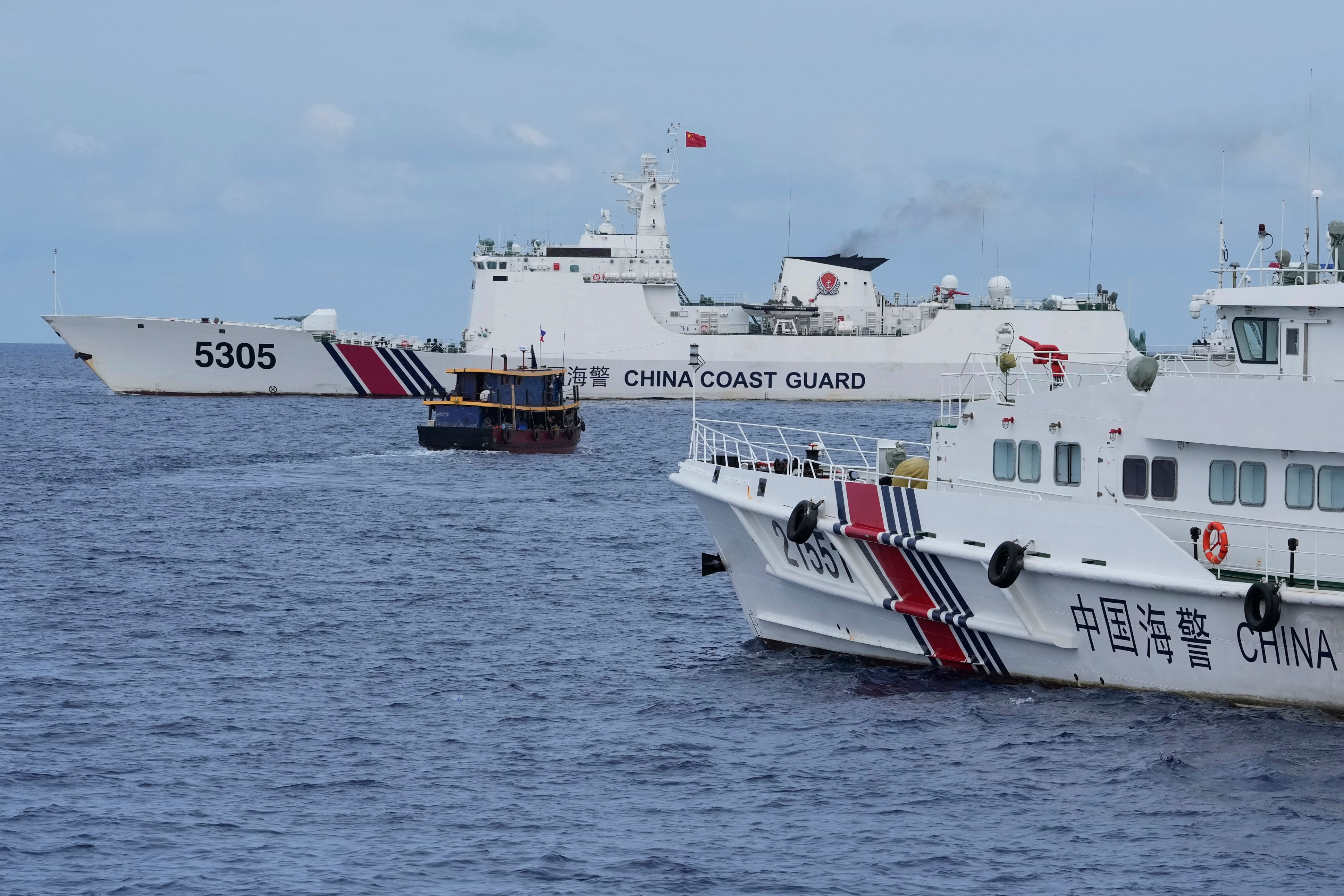China is upping its game in the South China Sea with a formidable new coastguard vessel poised to assert its wide-ranging territorial claims. [This month, the South China Morning Post (SCMP) reported that China is advancing its maritime capabilities with the construction of a new coastguard vessel modeled after a sophisticated destroyer outfitted with state-of-the-art surveillance technology.](https://www.scmp.com/news/china/military/article/3274494/chinese-coastguard-set-get-new-ship-modelled-advanced-type-052d-destroyer)
SCMP says that the vessel, spotted at Shanghai’s Jiangnan Shipyard, is intended for deployment in the contentious East and South China Seas, particularly in areas disputed with the Philippines. The report notes the new ship’s development comes amid China’s rising territorial disputes in these regions.
SCMP says that the ship, based on the Type 052D guided-missile destroyer, has been modified for coastguard duties, seen in the removal of the vertical launch system and installation of a 76mm main gun. It notes that the ship, equipped with Type 382 air search radars, boasts enhanced air surveillance capabilities.
A Powerful New Addition
The same report says that China’s new coastguard vessel, with a displacement range of 6,000 to 7,000 tons, fills a strategic gap and is comparable to Japan’s larger coastguard vessels. It notes that the ship has an operational range of over 6,000 nautical miles, allowing extended patrols in the South China Sea without frequent resupply.
The massive new vessel may be a follow-on design of its Zhaotou-class maritime law enforcement (MLE) vessels. In a 2019 Naval War College Review article, Andrew Erickson and other writers mention that the class is the world’s largest ship of its type.
The Rise of the Zhaotou-Class
Erickson and others note that these colossal cutters, each exceeding ten thousand tons and measuring 165 meters in length, are a testament to China’s shipbuilding prowess and strategic emphasis on MLE. They say that the Zhaotou-class, part of China’s second sea force centered on the consolidating China Coast Guard (CCG), has been designed to operate anywhere globally with maximum endurance.
Regarding equipment, Erickson and others mention that the Zhaotou features a helicopter deck and can be equipped with a 76mm main gun. However, they note that despite the Zhaotou’s impressive size and capabilities, the rationale behind its construction remains speculative, suggesting that it was built in response to Japan’s deployment of its Shikishima-class cutters.
The deployment of the Zhaotou MLEs in the South China Sea may give clues on how China plans to use an even larger vessel of its type. In a May 2023 Proceedings article, Collin Koh mentions that China has been deploying its formidable Zhaotou MLE vessels to assert territorial claims and dominance in the South China Sea.
Gray Zone Aggression
Koh notes that these vessels, exemplified by the Haijing 3901 recently deployed off the Philippines, are a significant part of China’s maritime strategy, blurring the lines between military and nonmilitary actions. He notes that China’s strategy, often referred to as “gray zone” aggression, involves coercive tactics that stop short of prompting a conventional military response.
Koh notes that, despite being outmatched by China’s naval power, Southeast Asian countries actively resist Beijing’s maritime coercion through the deployment of their limited naval and coast guard assets. He asserts that their resistance is crucial as the region grapples with the economic imperative of maintaining relations with China while defending their national interests.
Koh adds that the international community, particularly the US, plays a supportive role by enhancing maritime domain awareness and providing capacity-building assistance to these smaller nations. However, he points out that the disparity in maritime force levels remains challenging, with calls for more significant intervention and indigenous shipbuilding capacities to bolster Southeast Asian nations’ maritime presence against China’s gray zone tactics.
Implications for the South China Sea
China’s introduction of its new coastguard vessel further highlights the disparity in maritime law enforcement capability between China and other countries claiming territory in the South China Sea, especially the Philippines. The CCG has larger and more capable vessels than the Philippine Coast Guard (PCG), which gives it an advantage in sea endurance and operational capabilities, particularly in contested areas like the Second Thomas Shoal.
These Chinese vessels are designed to operate continuously for extended periods, providing China with a strategic advantage in enforcing its maritime claims and controlling contested waters. In contrast, the PCG’s smaller fleet struggles with limited endurance and the need for frequent resupply and maintenance, hampering its ability to assert a continuous presence in the region.
Manila’s challenges in enforcing its territorial claims in the South China Sea are underscored by China’s blocking and harassing its resupply missions to the contested Second Thomas Shoal, its underfunded military and coast guard and US ambiguity over supporting Philippine territorial claims under the two sides’ mutual defense treaty.
The Philippines' Assertive Transparency Campaign
Despite those challenges, the Philippines has mounted an “assertive transparency” campaign to protect its sovereignty and territorial integrity in the South China Sea. The strategy uses visual proof and media attention to bring attention to China’s assertive actions at sea, galvanize domestic and international backing and impose reputational costs on China.
The Philippines utilizes several tools to implement its assertive transparency strategy, including deploying PCG and Philippine Navy (PN) vessels with embedded journalists to document Chinese harassment, increasing maritime patrols and enhancing its maritime domain awareness through technological upgrades. Additionally, the Philippines leverages international support by engaging allies such as the US, Japan and Australia for joint patrols, military aid and diplomatic backing – all crucial to sustaining the strategy.
Strengthening the Philippine Coast Guard
Josiah Gottfried mentions in a March 2024 article for the Center for Strategic and International Studies (CSIS) think tank that the PCG has undergone a significant transformation in recent years, bolstering its maritime security capabilities amid growing regional tensions and territorial disputes. Gottfried mentions that the historically underfunded and underequipped PCG began its modernization following the 2012 Scarborough Shoal standoff with China, which glaringly exposed its limitations.
He notes that with international assistance from Japan and increased domestic prioritization, the PCG has more than doubled its fleet, improved maritime domain awareness and expanded its personnel from 4,000 in 2015 to 30,000. Gottfried notes Japan’s significant support in strengthening the PCG by providing 12 large ships and radar stations, and the US contribution of training facilities and backing of its National Coast Watch System (NCWS).
He says other global partners like France, Germany, Australia, Canada and the EU have also provided valuable support. Gottfried adds that the PCG’s budget has quadrupled, reflecting its enhanced role in Philippine maritime security. However, he points out that the PCG still faces challenges in maintaining a consistent presence in the South China Sea.
The Future of Maritime Power
The development of this new coastguard vessel marks a significant step in China’s efforts to enhance its maritime presence and assert its claims in the South China Sea. It is a stark reminder of the growing disparity in maritime capabilities between China and its regional counterparts, and the need for those countries to strengthen their own maritime forces to counter China’s assertive tactics.
The potential for escalation remains a concern, but international cooperation and diplomatic efforts are crucial to prevent further tensions in the region. The South China Sea remains a critical waterway for global trade and stability, and its future hinges on a peaceful resolution of maritime disputes through dialogue and collaboration.


















